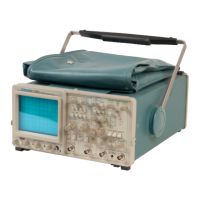Basic Applications-2465 Operators
4.
Set both VOLTSIDIV switches to produce displays
11. Rotate the
6
SECID IV switch three to six positions
of approximately four to five divisions in amplitude. clockwise to obtain a high degree of resolution of the
measurement points. Use
XI0 MAG as required for
optimum resolution. Observe that two alternate
B
Delayed
5. Press up on the Trigger MODE switch to acquire Sweep traces (one for each intensified zone) appear in the
the correct AUTO LVL for triggering.
display.
6. Use the Channel
1
and Channel
2
POSITION controls
to vertically center both displays.
12. If desired, the B Delayed Sweep traces can be
displayed alone, without the A lntensified trace. Pressing
in the
B
SECIDIV knob eliminates the A lntensified trace
7.
Set the A SECIDIV switch to display the measure-
from
the display.
ment points of interest within the graticule area.
8.
Activate the A lntensified Sweep by pulling out the
B
SECID IV knob.
13. Center the
6
Delayed traces vertically using the
Channel VERTICAL POSITION controls and the TRACE
SEP control
as
necessary.
9. Activate the Delta Time measurement function by
momentarily pressing the At switch; select the independent
mode of delay-time positioning (TRACKINGIINDEP
button out).
14.
Adjust both the A REF OR DLY POS control and
the
A
control to superimpose the measurement points of
the two
B
Delayed Sweeps (see Figure 6-9B).
10. Adjust the A REF OR DLY POS control to align
the start of the Reference intensified zone with the start of
the reference-signal point of interest. Use the A control
to align the start of the Delta intensified zone with the start 15. Read time difference directly from the crt At
of the comparison-signal point of interest (see Figure 6-9A).
readout.
CHANNEL
1
(REFERENCE)
REFERENCE INTENSIFIED ZONE
50%
AMPLITU
LEVEL
CHANNEL
2
(COMPARISON)
DELTA
TENSlFlED
ZONE
TIME
DIFFERENCE
A1
-
0.28
V
9
,111
CH
1
SIGNAL
--
+-
--
CH
I
SIGNAL
CH
AND
CH
2
SUPERIMPOSED
I
INTERVAL
i+
-1
I
BEING
I
(A) ATRACE MEASURED (B) B TRACE
3832-21
--
Figure
6-9.
Time difference between two time-related pulses (delayed-sweep method).

